Video Tutorial - Creating an AWS integration
Video Tutorial - Creating an AWS integration
In order to integrate with AWS S3, you must:
- Create a new AWS integration in Encord.
- Create a permission policy for your resources to allow Encord the necessary access.
- Create a role for Encord and attach the policy so that Encord can access those resources.
- Activate Cross-origin resource sharing to allow Encord to access those resources from a web browser.
- Configure Cache-Control on your bucket or objects
- Test the integration to ensure it works.
Create an S3 bucket to store your files if you have not done so already. The S3 bucket must have STS available and enabled.
- Set your bucket permissions to block all public access.
- Ensure that the Storage Class of all files is set to ‘S3 Standard’.
1. Start setting up the AWS integration
- In the Integrations section of the Encord platform, click +New integration to create a new integration and select AWS.

- Give your integration a meaningful title.

2. Create a permission policy
You can create a permission policy using the AWS cli or using the AWS Console UI.Use the AWS cli
Log in to AWS cli and run the following code.Use the AWS Console UI
-
In Encord, copy the JSON from Step 2 of the integration.
For example:
- In AWS, navigate to Identity and Access Management (IAM) and select Policies.
- Click Create policy to create a new policy.
- Select JSON as the Policy editor

- Paste the JSON you copied from Encord into the Policy editor, replacing the
arn:aws:s3YourBucketvalue for Resource with your bucket’s Amazon Resource Name (ARN). The ARN can be found in the Properties tab of your S3 bucket. When pasting your bucket ARN into the JSON policy editor, ensure that the Resource value ends in/*. Click the Next button to continue.
-
s3:PutObjectis needed for features that require write permissions, including re-encoding data and creating image sequences. -
s3:ListBucketis OPTIONAL. Cloud Synced Folders requiress3:ListBucketread permissions to sync data stored in your buckets to Encord Cloud Synced Folders .
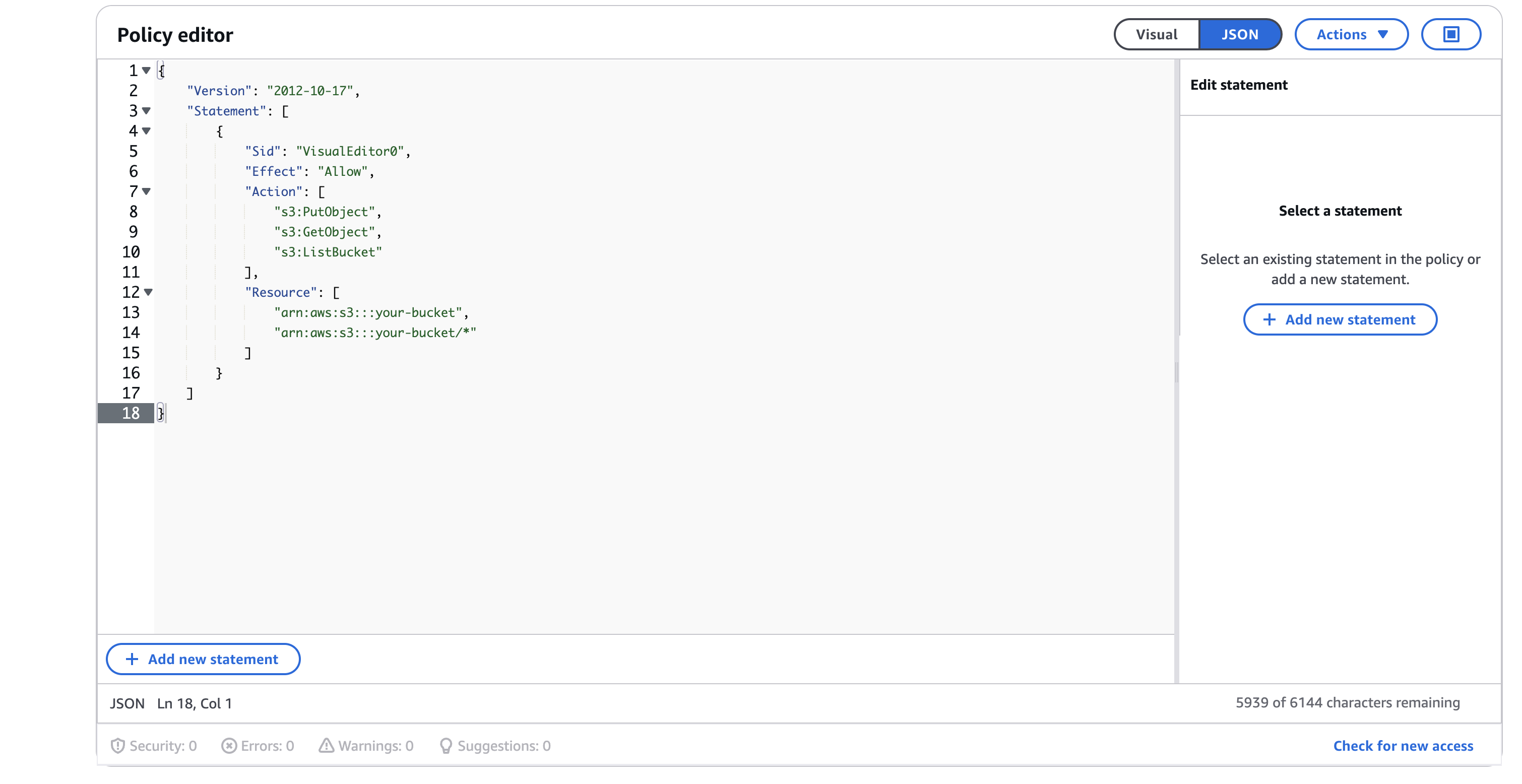

- Add any tags according to your Workspace’s resource tagging policy, and give your policy a descriptive name (used when creating a role for Encord). Click Create policy to finish creating your policy.
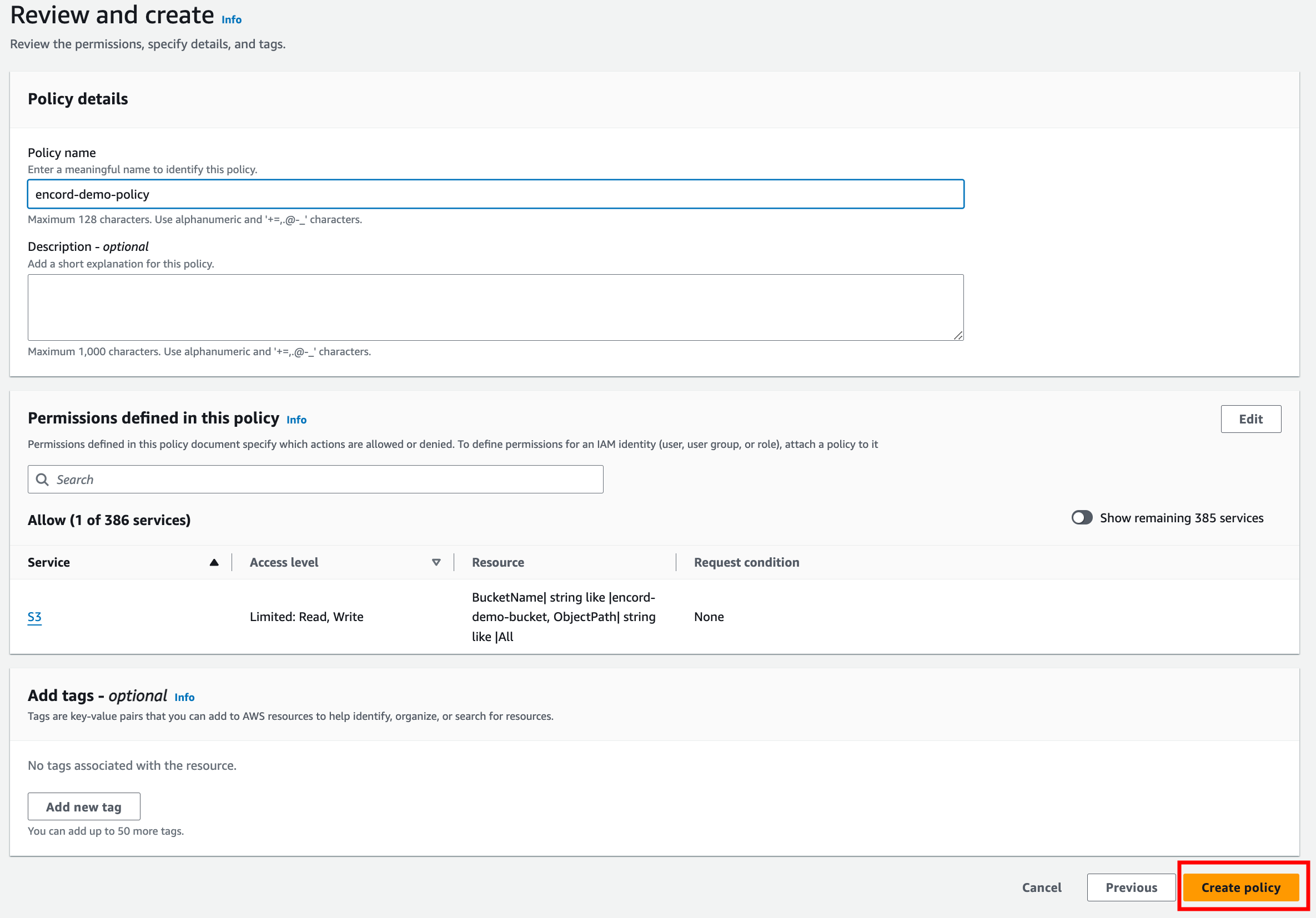
- Click Create policy to finish creating your policy.
3. Create a role for Encord
- In AWS, navigate to Roles and click the Create role button.

- For Trusted entity type select AWS Account and in the An AWS Account section select Another AWS account.

- In Encord copy the Encord AWS account ID from Step 3 of the integration (shown below), and paste it into the Account ID field in AWS (shown above). In AWS, check Require external ID under Options to reveal the External ID field.
- Navigate back to Encord and click Generate and copy to copy an External ID.

- In AWS, paste the External ID you generated into the External ID field and click Next.

- Select the IAM policy you created in Step 2 and click Next to attach it to the role.

- Give your role a descriptive name and click the Create role button.
- Copy the Role ARN and the name of the role you just created.

- In Encord, paste the name of the role and the Role ARN into Step 3 of the integration.

4. Allow Cross-origin resource sharing (CORS)
- In Encord, expand Step 4 of the integration. Copy the CORS JSON policy.
- Navigate to the Permissions tab of your S3 bucket. Scroll to the bottom of the page and click Edit in the Cross-origin resource sharing (CORS) heading.
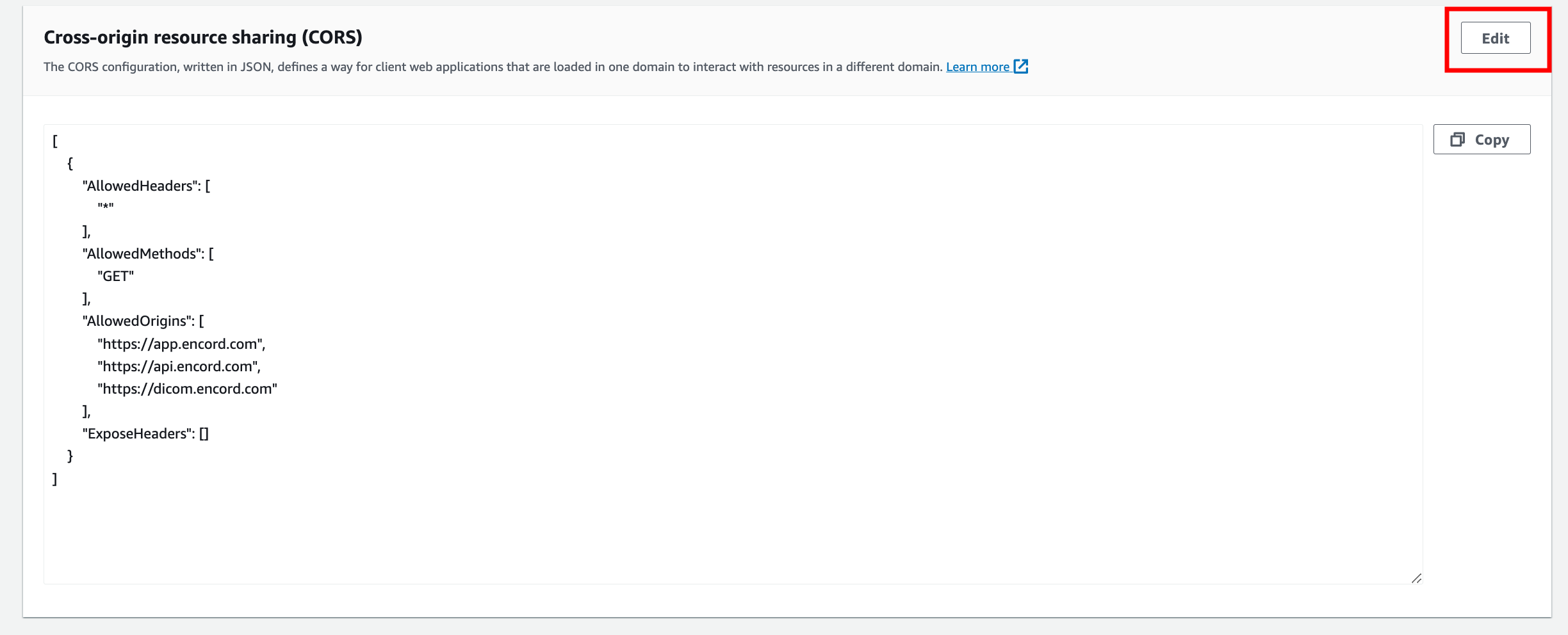
- Paste the JSON into the editor that pops up. Click Save changes to finish settings up CORS.
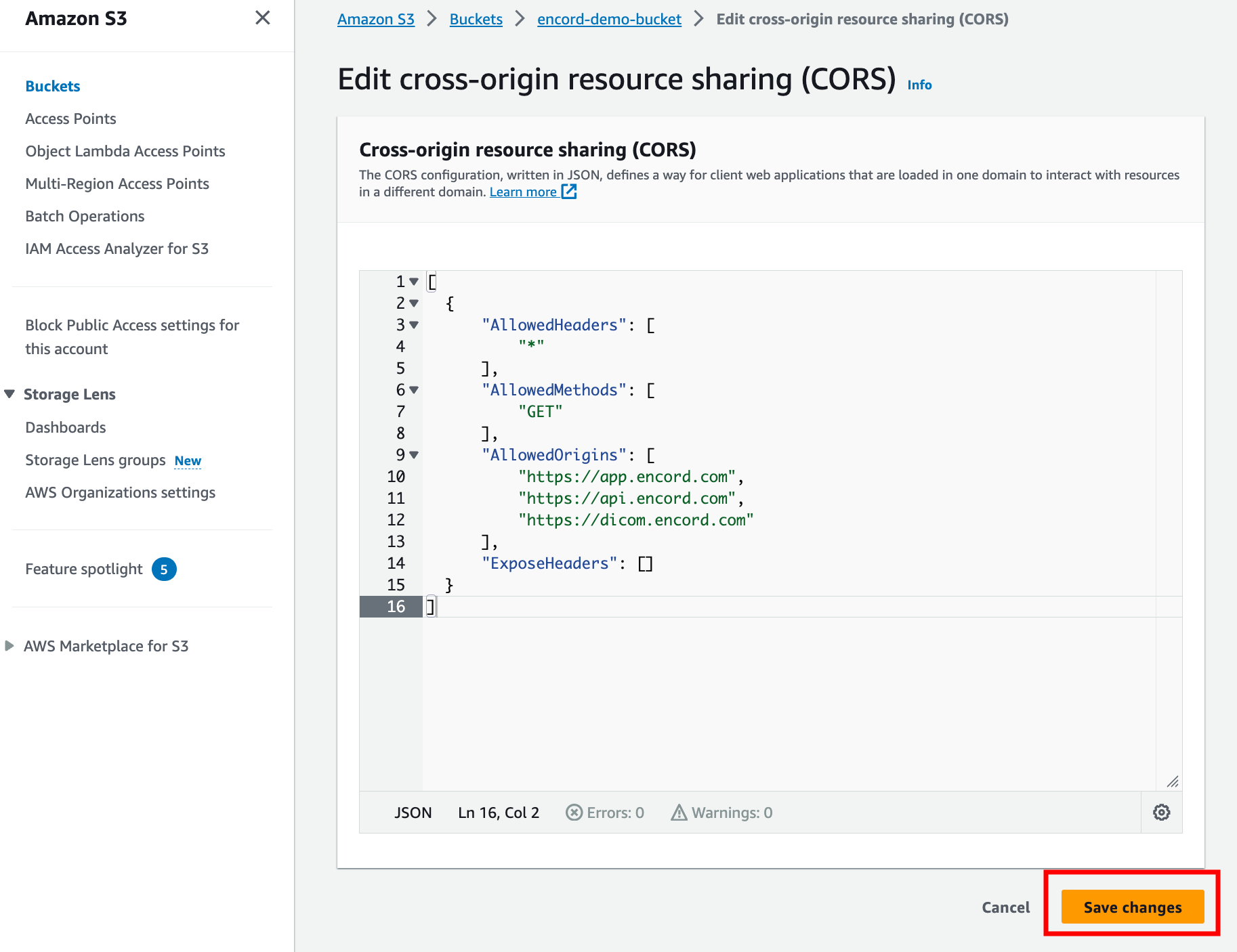
- Navigate back to Encord and click Create to finish the integration set up.
5. Update Metadata Settings in AWS
Add Cache-Control headers to your AWS folders or objects, following the AWS instructions here. Adding Cache-Control headers significantly increases the speed at which your files load in the Label Editor.6. Test the Integration
This test confirms Encord can assume the specified role, but does not guarantee bucket access. If data onboarding is unsuccessful despite passing the test, verify Encord’s bucket permissions and the accuracy of your object URLs.
- Click the Run a test button on the integration, to test the integration.
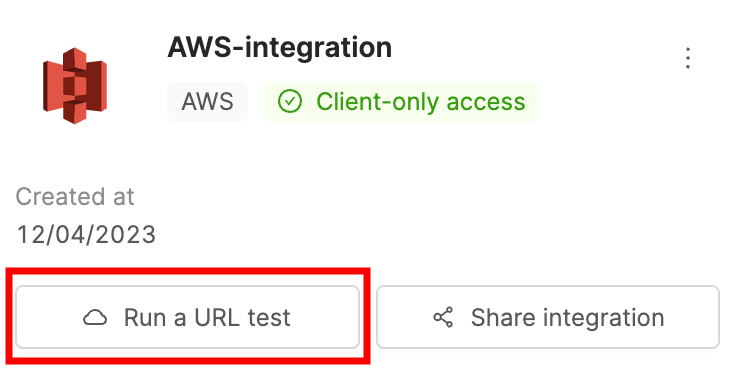
- Paste the URL of any object in the bucket and click Check Encord can access this URL. If the test is successful a green tick appears next to Encord infrastructure and This machine.
Registering AWS Data
Navigate to the Register cloud data page for guidance on how to register files stored in AWS.Create a Multi-Region Access Point Integration
Using Multi-Region Access Points requires you to do a few things differently when setting up an AWS integration.- When creating a permission policy for your multi-region access point in AWS, make sure to list the ARN of the Multi-Region Access Point, as well as the ARNs of all constituent buckets in the JSON.
Example JSON
Example JSON
- Make sure you create a CORS policy for every bucket that is included in your Multi-Region Access Point.
- When uploading data to a dataset using the Multi-Region Access Point integration, make sure your JSON file is formatted correctly for use with a Multi-Region Access point - as documented here.
Terraforming your AWS S3 Integration
This guide is intended as a supplement to the Terraform documentation provided by Hashicorp here.
- An S3 Bucket
- An IAM Policy
- An IAM Role
- A CORS Policy
Declaring your Terraform providers
In the below example, we’re using Hashicorp’s AWS provideraws and the tfvars utility that allows us to neatly define values to pass into variables.
We also define an alias as well as a Region for the AWS provider, which needs to match the location in which you want your bucket to be provisioned.
Declaring your variables
In yourvariables.tf file, you will need to define the variables into which you want to pass values. An example is below:
Defining your variables in a .tfvars file to avoid having to manually edit the Terraform files
Since we’ve opted to use tfvars we need to create a corresponding .tfvars file and specify some values we wish to pass into the variables you just defined:
Creating the required resources
The resources you need to create include:- The AWS S3 bucket itself
- The AWS Bucket CORS Policy to allow Cross Origin Resource Sharing with the Encord domains
- The IAM Role
- The IAM Policy
- The IAM Policy attachment that binds the Role to the Policy
Defining the Bucket, Bucket ACL, and Bucket CORS Policy:
Defining the IAM Policy:
Attaching the Role to the Policy:
terraform plan to preview the changes and check you are happy with them.
Once your Terraform has been applied, return to the Encord application, and test your integration.
The entire resources file
s3-resources.tf now looks like this:


